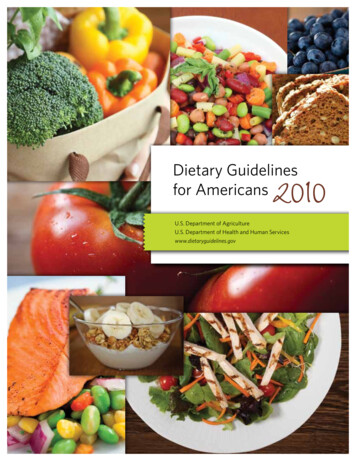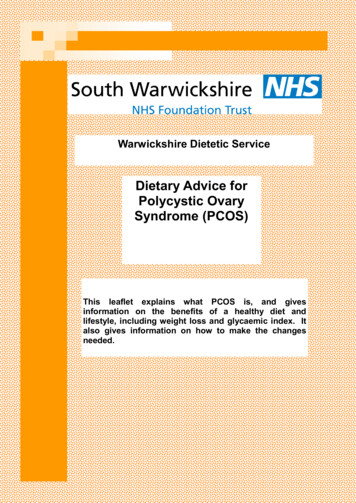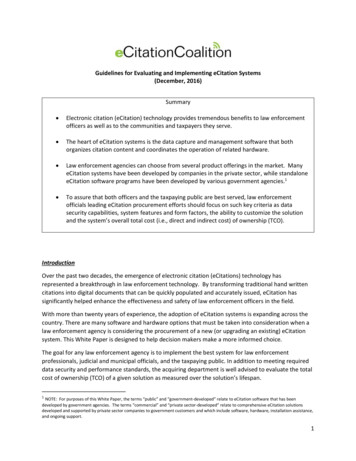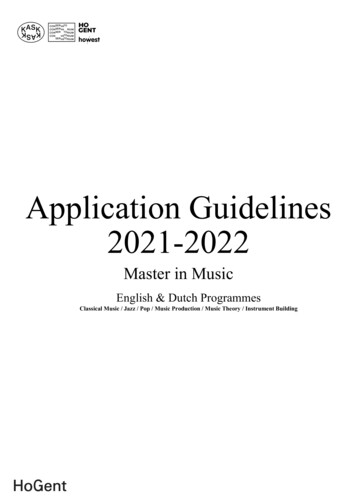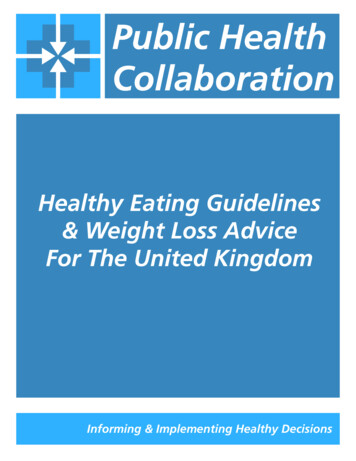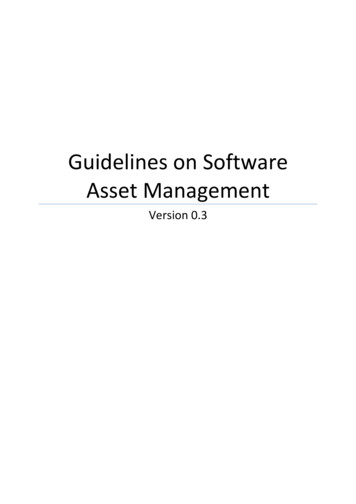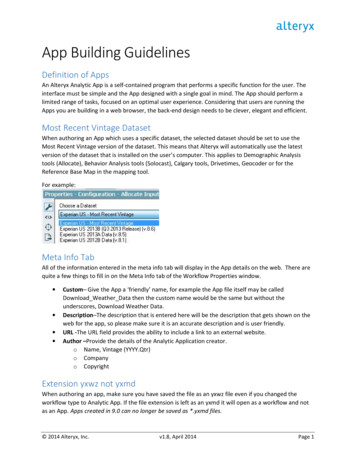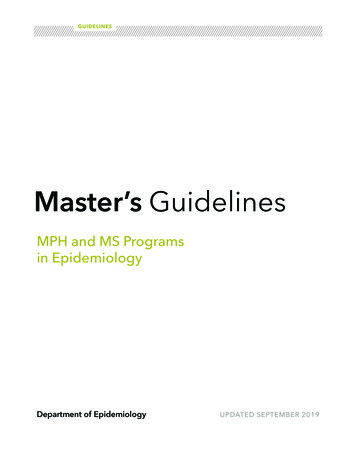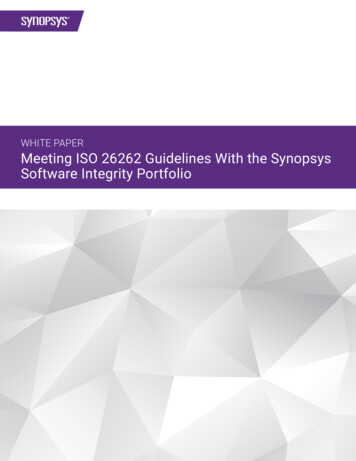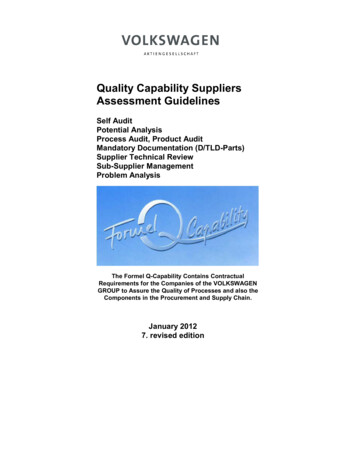
Transcription
DIETARY GUIDELINESFOR INDIANS-A ManualNATIONAL INSTITUTE OF NUTRITIONHyderabad – 500 007, INDIA
First PublishedReprintedSecond Edition.19981999, 2003, 2005, 20072011ATTENTION READERSReaders can download the soft copy of the “Dietary Guidelinesfor Indians” free of cost for their own use and also fordissemination of information for the benefit of the society on nonprofit basis. Readers are not supposed to either reproduce / copy /reprint the same for commercial purpose. If the information is usedin some context, the source of information with properacknowledgement to the National Institute of Nutrition,Hyderabad should be mentioned. Usage of the information shouldbe intimated to the Director, NIN in advance and approval shouldbe sought. All copyrights are reserved with NIN.
WORKING GROUP OF THE FIRST EDITIONNational Institute of NutritionHyderabadChairpersonDr.Kamala KrishnaswamyDirectorMembersDr.Bhaskaram P.Deputy Director (Sr. Grade)Dr.Bhat RV.Deputy Director (Sr. Grade)Dr. GhafoorunissaDeputy Director (Sr. Grade)Dr. Raghuram TC.Deputy Director (Sr. Grade)Dr. Raghuramulu N.Deputy Director (Sr. Grade)Dr. Sivakumar B.Deputy Director (Sr. Grade)Dr.Vijayaraghavan K.Deputy Director (Sr. Grade)Assistance rendered by Dr.Damayanthi K,Mr. Pulkit Mathur, Ms. Sujatha T, Ms. Uma NayakDr. Vasanthi S and Dr. Vijayalakshmi K, in thepreparation of Annexures is gratefully acknowledged.
EXPERT ADVISORY GROUP OF THE FIRST EDITIONDr. Achaya KT.CSIR Emeritus-ScientistBangaloreDr. Rajammal P DevadasChancellorAvinashalingam deemed UniversityCoimbatoreDr. Bamji. Mahtab S.Former Director-Grade Scientist, NINICMR Emeritus scientistHyderabadDr. Ramachandran A.Diabetes research CentreChennaiDr. Bhan MK.Additional ProfessorAll India Institute of Medical SciencesNew DelhiDr. Rao MVFormer Vice-ChancellorA.P.Agricultural UniversityHyderabadDr. Leela RamanFormer Deputy Director (Sr.Grade), NINHyderabadDr. Srinath Reddy K.Prof. CardiologyAll India Institute of Medical SciencesNew DelhiDr. Mary MammenChief DietitianChristian Medical College & HospitalVelloreDr. Subhadra SeshadriHead, Dept. of Food & NutritionM.S. UniversityBarodaDr. Narasinga Rao BS.Former Director, NINHyderabadDr. Sushma SharmaReader in NutritionLady Irwin CollegeNew DelhiDr. Pralhad Rao N.Former Deputy Director (Sr.Grade), NINHyderabadDr. Vinodini ReddyFormer Director, NINHyderabadDr. Prema RamchandranAdviser (Health)Planning CommissionNew Delhi
WORKING GROUP OF THE SECOND EDITIONNational Institute of NutritionHyderabadDr. Kamala Krishnaswamy .ChairpersonFormer Director, NINDr.B.Sesikeran.Co-Chairperson.Convener.Member SecretaryDirector, axmiMr.Anil Kumar DubeDr.D.Raghunatha jun L. KhandareDr.Bharathi KulkarniDr.K.DamayanthiDr.KV.RadhakrishnaDr. M. RadhikaDr.N.ArlappaDr. Kalpagam PolasaDr.Rita SaxenaDr.V.Sudershan RaoDr.Y.VenkataramanaAssistance rendered by the artist Mr. S. Devendran in designing the revised edition;Mr.P.S. Ramarao for technical assistance; Mr. B. Omprakash, Mr. N. Satyanarayanaand Mr. V. Bhuvaneswaran of the Printing Division, NIN is gratefully acknowledged.
AcknowledgmentsWe are thankful toFood and Nutrition Security CommunitySolution Exchange GroupandDr. Anura Kurpad,Dean, St. John’s Research Institute, Bangalorefor their valuable comments and inputs.
CONTENTSPageForewordiPrefaceiiIntroduction1Current Diet and Nutrition Scenario3Dietary Goals9Dietary Guidelines10Guideline 111Guideline 221Guideline 325Guideline 429Guideline 534Guideline 640Guideline 745Guideline 852Guideline 956Guideline 1060Guideline 1163Guideline 1267Guideline 1370Guideline 1475Guideline 1579Annexures1. Approximate Calorific Value of Nuts, Salads and Fruits852. Balanced Diet for Adults - Sedentary/Moderate/Heavy Activity862a. Sample Meal Plan for Adult Man (sedentary)872b. Sample Meal Plan for Adult Woman (sedentary)883. Recommended Dietary AllowancesMacronutrients89Micronutrients904. Balanced Diet for Infants, Children and Adolescents91
5. Anthropometric Standards926. Low Calorie Vegetables and Fruits ( 100 Kcal)1047. Vegetable and Fruits with High Calorie Value ( 100 Kcal)1058. Approximate Calorific Value of Some Cooked Preparations1069. ALA Content of Foods (g/100g)11010.Glycemic Index of Common Foods11111.Exercise and Physical Activity11212.Removal of the Pesticide Residues from the Food Products11413.Drinking Water Standards11614.Portion Sizes and Menu Plan11715.Some Nutrient-rich Foods118BOOKS FOR FURTHER READING121GLOSSARY123
FOREWORD- Dr. C. GOPALANFounder PresidentNutrition Foundation of IndiaIt is now more than a decade since this valuable publication was first prepared.It was compiled by a team of experienced nutrition scientists at the NationalInstitute of Nutrition, Hyderabad, under the leadership of Dr. KamalaKrishnaswamy. It has received wide appreciation from the general public as well asfrom students of nutrition, medicine, home science, nursing and allied subjects, andhas been reprinted several times. It has also been widely disseminated throughoutreach activities undertaken by the National Institute of Nutrition, in the form oflectures, exhibitions and distribution of materials in various local languages.In the intervening years, there have been notable socio-economic changes inIndia. It was thought necessary to update the guidelines in the light of newdevelopments and fresh information.The most notable change has been in the overall economic scenario in thecountry, with a robust growth rate. There have also been some importantgovernment initiatives in the fields of health and nutrition and poverty alleviation,including the launching of MGNREGA and overhauling of the ICDS. Globalisationhas resulted in the opening of multinational fast food chains in Indian cities,including the smaller cities. Lifestyles and dietary patterns that had started givingearly warning signals towards the end of the previous century, when theseguidelines were first published, are continuing to follow a trend that promotesobesity and the attendant non communicable diseases.The improvement in the overall economy at the macro level and concomitantimprovements in purchasing power (though unevenly distributed) amonghouseholds have not led to the expected levels of improvement in the nutritionalstatus of Indians. The latest findings of the National Family Health Survey, NFHS-3showed virtually no improvement in parameters as compared to NFHS-2, andrecent surveys by the National Nutrition Monitoring Bureau have thrown morelight on the growing problem of the 'double burden' of undernutrition andovernutrition. These data should serve as a wake-up call to nutritionists and policymakers. There is very obviously an 'awareness and information deficit', evenamong the more affluent sections of the population, about good dietary practicesand their linkage with good health. This deficit should be narrowed and eliminatedby harnessing all traditional as well as modern technological vehicles ofcommunication.This updated version of DGI from India's premier nutrition institute, NationalInstitute of Nutrition, should serve as a valuable source of concise, accurate andaccessible information, both for members of the general public and those who areinvolved in dissemination of nutrition and health education.
PREFACEThe first edition of 'Dietary Guidelines' was published in 1998, and since thenmany changes have taken place in the country. The economic transition hastransformed the way people live. Changing lifestyles of people both in rural andurban areas are seen to alter the very structure of our society at a rapid pace today.The shift from traditional to 'modern' foods, changing cooking practices, increasedintake of processed and ready-to-eat foods, intensive marketing of junk foods and'health' beverages have affected people's perception of foods as well as their dietarybehaviour. Irrational preference for energy-dense foods and those with high sugarand salt content pose a serious health risk to the people, especially children. Theincreasing number of overweight and obese people in the community and theresulting burden of chronic non-communicable diseases necessitate systematicnutrition educational interventions on a massive scale. There is a need for adoptionof healthy dietary guidelines along with strong emphasis on regular physicalexercise.Today, the multiple sources of health and nutrition related information tend tocreate unnecessary confusion among people. This book makes an attempt to informus on matters of everyday nutrition in a user friendly manner and thus, aims toinfluence our dietary behavior. These guidelines deal with nutritional requirementsof people during all stages of their life, right from infancy to old age.We earnestly hope that readers will enjoy reading the book and benefit from itand also spread the valuable information among those around them.ii
INTRODUCTIONNutrition is a basic human need and a prerequisite to a healthy life. A properdiet is essential from the very early stages of life for proper growth, developmentand to remain active. Food consumption, which largely depends on production anddistribution, determines the health and nutritional status of the population. Therecommended dietary allowances (RDA) are nutrient-centred and technical innature. Apart from supplying nutrients, foods provide a host of other components(non-nutrient phytochemicals) which have a positive impact on health. Sincepeople consume food, it is essential to advocate nutrition in terms of foods, ratherthan nutrients. Emphasis has, therefore, been shifted from a nutrient orientation tothe food-based approach for attaining optimal nutritional status. Dietary guidelinesare a translation of scientific knowledge on nutrients into specific dietary advice.They represent the recommended dietary allowances of nutrients in terms of dietsthat should be consumed by the population. The guidelines promote the concept ofnutritionally adequate diets and healthy lifestyles from the time of conception to oldage.Formulation of dietary goals and specific guidelines would help in providingrequired guidance to people in ensuring nutritional adequacy. The dietaryguidelines could be directly applied for general population or specific physiologicalor high risk groups to derive health benefits. They may also be used by medical andhealth personnel, nutritionists and dietitians. The guidelines are consistent with thegoals set in national policies on Agriculture, Health and Nutrition.The dietary guidelines ought to be practical, dynamic and flexible, based on theprevailing situation. Their utility is influenced by the extent to which they reflect thesocial, economic, agricultural and other environmental conditions. The guidelinescan be considered as an integral component of the country's comprehensive plan toreach the goals specified in the National Nutrition Policy.The major food issues of concern are insufficient/ imbalanced intake offoods/nutrients. The common nutritional problems of public health importance inIndia are low birth weight, protein energy malnutrition in children, chronic energydeficiency in adults, micronutrient malnutrition and diet-related noncommunicable diseases. However, diseases at the either end of the spectrum of
malnutrition (undernutrition and overnutrition) are important. Recent evidencesindicate that undernutrition in utero may set the pace for diet-related chronicdiseases in later life. Population explosion, demographic changes, rapidurbanization and alterations in traditional habits contribute to the development ofcertain unhealthy dietary practices and physical inactivity, resulting in diet-relatedchronic diseases.The dietary guidelines emphasize promotion of health and prevention ofdisease, of all age groups with special focus on vulnerable segments of thepopulation such as infants, children and adolescents, pregnant and lactatingwomen and the elderly. Other related factors, which need consideration arephysical activity, health care, safe water supply and socio-economic development,all of which strongly influence nutrition and health.In this document, food-related approaches, both in qualitative and quantitativeterms, have been incorporated. Emphasis is on positive recommendations whichcan maximize protective effects through use of a variety of foods in tune withtraditional habits. The higher goals set with respect to certain food items such aspulses, milk and vegetables/fruits are intended to encourage appropriate policydecisions. Suitable messages for each of these guidelines have been highlighted.A variety of foods, which are available and are within the reach of the commonman, can be selected to formulate nutritionally adequate diets. While there are onlyfour accepted basic food groups, in India, there are a variety of food preparationsand culinary practices. Different cereals/millets are used as staple food, apart froma variety of cereal/millet/pulse combinations in different regions of India. Thecooking oils and fat used are of several kinds. The proposed guidelines help toformulate health promoting recipes and diets which are region- and culturespecific. It is difficult to compute standard portion sizes, common to all regions ofIndia. Nevertheless, attempts are made to give portion sizes and exchanges.Translation of knowledge into action calls for the coordinated efforts of severalgovernment and non-government organizations. The fifteen guidelines prescribed,herein, stress on adequacy of intake of foods from all food groups for maintenanceof optimal health. Effective IEC strategies and other large-scale educationalcampaigns should be launched to encourage people to follow the dietaryguidelines. Such efforts should be integrated with the existing national nutritionand health programs.2
CURRENT DIET AND NUTRITION SCENARIOHealth and nutrition ar
Current Diet and Nutrition Scenario 3 Dietary Goals 9 Dietary Guidelines 10 Guideline 1 11 Guideline 2 21 Guideline 3 25 Guideline 4 29 Guideline 5 34 Guideline 6 40 Guideline 7 45 Guideline 8 52 Guideline 9 56 Guideline 10 60 Guideline 11 63 Gui deline 12 67 Guideline 13 70 Guideline 14 75 Guideline 15 79 Annexures 1. Approximate Calorific Value of Nuts, Salads and Fruits 85 2. Balanced Diet .
